What is it?
Dental bridges are fixed dental prostheses used to replace one or more missing teeth by bridging the gap between natural teeth or dental implants. They consist of one or more artificial teeth, known as pontics, which are attached to adjacent natural teeth or implants for support. Bridges are custom-made to match the color, size, and shape of the patient’s natural teeth, restoring both function and aesthetics to the smile.
Here are the key aspects of dental bridges:
- Types of Bridges:
- Traditional Bridges: These are the most common type of bridges and consist of one or more pontics attached to dental crowns, which are cemented onto the natural teeth adjacent to the gap.
- Cantilever Bridges: In cases where there is only one adjacent tooth next to the gap, a cantilever bridge may be used. This type of bridge is anchored to only one natural tooth or implant.
- Maryland Bridges (Resin-Bonded Bridges): Maryland bridges use metal or porcelain wings bonded to the backs of adjacent natural teeth, eliminating the need for dental crowns. They are often used for replacing front teeth.
- Procedure:
- The process of getting a dental bridge typically involves two or more dental appointments.
- During the initial appointment, the dentist prepares the abutment teeth, which are the natural teeth adjacent to the gap, by removing a portion of their enamel to accommodate the dental crowns.
- Impressions of the prepared teeth and the surrounding dental structures are taken to fabricate the custom-made bridge in a dental laboratory.
- A temporary bridge may be placed to protect the prepared teeth while the final bridge is being fabricated.
- Once the bridge is ready, the temporary bridge is removed, and the final bridge is cemented into place, restoring function and aesthetics to the smile.
- Benefits of Dental Bridges:
- Restoration of Function: Dental bridges restore the ability to chew and speak properly, which may be compromised by missing teeth.
- Aesthetic Improvement: Bridges fill in the gaps left by missing teeth, improving the appearance of the smile and restoring facial symmetry.
- Prevention of Tooth Movement: By filling in the space left by missing teeth, bridges help prevent neighboring teeth from shifting out of position.
- Longevity: With proper care and maintenance, dental bridges can last for many years, providing a durable and cost-effective solution for tooth replacement.
- Post-Treatment Care:
- Patients with dental bridges should practice good oral hygiene habits, including brushing twice a day, flossing daily, and attending regular dental check-ups and cleanings.
- Avoiding hard or sticky foods and habits like biting on pens or fingernails can help prolong the life of the bridge and prevent damage.
- Regular monitoring by a dentist is essential to ensure the bridge remains stable and functional over time.
In summary, dental bridges offer a reliable and effective solution for replacing missing teeth, restoring both function and aesthetics to the smile. With proper care and maintenance, bridges can provide patients with a long-lasting and natural-looking tooth replacement option.

